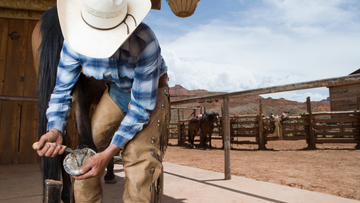What is Sidebone?
Sidebone is a hoof condition that affects the lateral cartilage of a horse. When a horse suffers from sidebone, this cartilage calcifies and hardens. Ultimately, this can significantly affect your horse because this cartilage is the shock absorption of the front foot.
A horse suffering from sidebone may experience pain, which will show in competition, exercise, or work. Sidebone is a less severe cause of lameness. However, ringbone is another disease that forms bony cysts and can cause severe lameness.
Causes of Sidebone Formation
 Repetitive trauma to the hoof is the most likely cause of sidebone issues. Improper shoeing or significant work on hard surfaces can lead to sidebone formation. Like most diseases, certain breeds are more prone to sidebone than others. This is primarily due to their bony structure and the jobs they perform. For instance, draft horses are more likely to develop sidebone because of the hard surfaces they work on. Older horses are also more likely to develop sidebone because their bodies do not heal as quickly as younger horses.
Repetitive trauma to the hoof is the most likely cause of sidebone issues. Improper shoeing or significant work on hard surfaces can lead to sidebone formation. Like most diseases, certain breeds are more prone to sidebone than others. This is primarily due to their bony structure and the jobs they perform. For instance, draft horses are more likely to develop sidebone because of the hard surfaces they work on. Older horses are also more likely to develop sidebone because their bodies do not heal as quickly as younger horses.
Symptoms and Diagnosis
Common Symptoms
If your horse is suffering from sidebone, he will likely show you through several symptoms:
- Progressive lameness
- Signs of pain
- Hard, bony growth on the side of the hoof
- Hoof is warm to the touch
Diagnostic Imaging Techniques
While the causes are not entirely known, sidebone is simple to diagnose because of the presence of the bony growth on the hoof. Most veterinarians will use an X-ray to confirm the growth and measure the extent of the damage.
Treatment Options
Non-Surgical Options
With early diagnosis, sidebone can be treated without surgery. You will need to focus on changing the environment around your horse. Limit access to hard surfaces and give your horse plenty of rest. Ask the farrier to provide a specialized shoe to support your horse. Additionally, your veterinarian may offer anti-inflammatory medications.
Surgical Interventions
Sometimes, the sidebone is too severe, or the non-surgical options do not help. In this case, your veterinarian will consider a neurectomy, arthrodesis, or a resection. The neurectomy cuts the nerves to the foot to reduce pain. An arthrodesis fuses the joints to minimize movement and reduce pain. Finally, a resection removes the troublesome bone or cartilage to reduce pain.
Prognosis and Recovery
When treated early, sidebone can have little impact on your horse. It can be managed and treated to reduce inflammation and pain. Most horses can continue their regular exercise and activities after rest.
Horses suffering more severe cases will require longer times of rehabilitation. This is especially true for horses who receive surgery to help alleviate the pain.
The path to recovery is highly based on the severity of the sidebone. Many horses will need long periods of rest to heal properly. You may need to confine your horse to his stall or allow for limited turnout time.
However, with proper shoeing, rest, and medical oversight, most horses recover to live longer with sidebone with little impact on their activities.






















